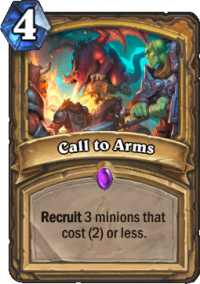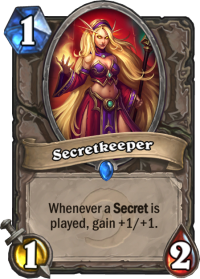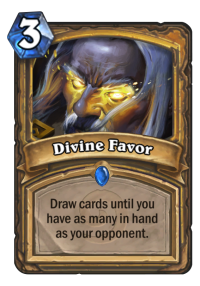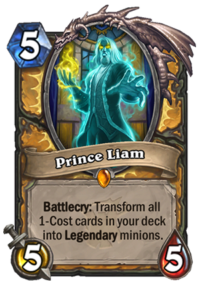Secret Paladin Mulligan Strategy & Guide
Higher Priority (Keep every time)

- Righteous Protector – Good 1-drop, can be annoying to trade with, gives the rest of your board some protection.
- Secretkeeper – If not removed right away, can snowball really well. Great 1-drop in a deck running 1 mana Secrets.
- Hydrologist – Solid 2-drop, while you don’t have Murloc synergies, it’s a body + extra card on T2, and that extra card synergizes with Secretkeeper too.
- Call to Arms – Always keep in every Paladin deck, it’s the best card in your entire deck, so there’s no reason to throw it away.
Lower Priority (Keep only if certain conditions are met)
- Argent Squire – Righteous Protector and Secretkeeper are betetr 1-drops, but keep this one if you don’t draw the other two.
- Noble Sacrifice or Redemption – If you have Secretkeeper already. Secrets aren’t great plays by themselves, but if you also give a minion +1/+1 on top of the Secret’s effect, then it’s well worth it. Repentance is a bad keep in the early game, though.
- Bellringer Sentry – Keep in slower matchups. Against Aggro, it’s a bit too slow and you prefer your early game instead.
Secret Paladin Play Strategy
Secret Paladin is a mix between Aggro and Midrange deck, leaning more towards Aggro. Your basic game plan is very similar to the other aggressive Paladin builds – flood the board over and over again and try to rush your opponent down before he stabilizes.
Vs Fast Decks
In fast matchups, tempo is by far most important. Most of the Aggro decks rely on the board to do anything and Secret Paladin is no different. When you have a board and your opponent does not in the mirror, you’re at a huge advantage. He will need to catch up, but every time he does, you should be able to dictate how the trades go and get even more ahead. In Aggro mirrors, getting absolutely ahead on the board usually means winning the match, even if you have less resources in your hand than your opponent.

Your best snowball tool is Secretkeeper. The card starts only as a 1/2, but it can quickly grow. Even playing a single Secret makes it a 1 mana 2/3, which is way over the curve and an amazing tempo play. Playing two Secrets makes it an absolute monster – you should be able to clear 2 or even 3 different minions with your 1 mana 3/4. Keep two things in mind. First – it doesn’t grow from the Secrets that are “put into the battlefield”, such as the ones you get from Bellringer Sentry. And second – it grows from both players’ Secrets – so if you face a Tempo Mage, a mirror matchup, or even a Murloc Paladin running Hydrologist, it might be relevant.
Other than that, your early game isn’t much different from other Paladin decks. You can do some snowballing with Knife Juggler or Dire Wolf Alpha if you get ahead, but that’s it. Turn 4 is probably the most swingy turn. You absolutely want to have one of your 4 mana plays – Call to Arms or Bellringer Sentry. Call to Arms is much better, because it’s a higher tempo play – 3 bodies are harder to deal with than one, pulling a Knife Juggler means that you might get some random damage immediately, and the total amount of stats will be higher than your other plays. However, Sentry is also a solid T4 play, maybe even great depending on the Secret he puts onto the board immediately. Repentance is a low roll, but both Noble Sacrifice and Redemption are very good.
In the mid game, you still want to fight for the board. Consecration and your weapon can let you respond to some boards reactively, but you still want to be as proactive as possible. Getting ahead with a lot of small minions also makes your Sunkeeper Tarim much better. Dropping Tarim after getting some value trades is a massive swing, and that’s usually more than an Aggro deck can handle.
Prince Liam is mostly played for his 5/5 body and not for the effect. Getting some random Legendaries might actually be even worse than having your 1 mana card sometimes. For example, that Righteous Protector is often a great mid/late game tempo play, especially with Tarim, and some random Legendary instead might be quite useless. Of course, if it’s Turn 5 and you have no other move, you should still drop Liam, I’m just saying that don’t try to get him out as quickly as possible – there’s no point.
Vs Slow Decks
Matchups vs slow decks are quite different. Instead of trying to control the board, you try to kill them as quickly as possible. Your deck has a pretty low curve, and you simply can’t win against a slow deck in the late game – they will run you out of resources in the long run.
Early game is most important. Just like vs Aggro, having a Secretkeeper is a big advantage – it can snowball very hard with just a few Secrets, and most of the Control decks might have a hard time answering a 3/4 on Turn 2/3. Cards like Knife Juggler or Dire Wolf Alpha are also better against slow decks, since they usually won’t have small bodies to trade with them. Knife Juggler that sticks to the board means 1-2 extra damage every turn, and that’s massive over the course of a few turns.

Call to Arms is still your best card and biggest swing, but funnily enough, you might want to hold it off in some cases. If you don’t have any board, your opponent just used a board clear or something, go ahead and drop Call to Arms. But if you have some minions already, especially some high value target such as Secretkeeper or Juggler, it’s much better to drop a Bellringer Sentry first. This card is much more resistant to AoEs, and even if it gets cleared, it still gets some Deathrattle value.
Divine Favor is very important in slower matchups. Since half of your deck costs 1 or 2 mana, you will run out of cards quite quickly. After you run out of cards, Divine Favor gives you a massive refill, usually enough to go for a few more turns without running out of steam. However, Divine Favor itself is a low tempo play, so drop it only when you really need it. Don’t play it on Turn 3 if you can develop something instead. Use it only only when you’re already running low on cards and you need more plays, or when you don’t want to play more stuff anyway – e.g. you have a solid board and you don’t want to play more anticipating a board clear, or when your opponent has played a Doomsayer you can’t answer. Of course, try to play as many cards before Divine Favor as you can – every card you play before is +1 card you draw. Don’t do it only if you’re looking for a specific card and you need mana to play it too (e.g. you’re at 7 mana and you look for a Spellbreaker, then you don’t play anything first).
Prince Liam is a very interesting card. The deck runs 10 one mana cards, and unless you’re holding onto a Divine Favor, those are really bad draws vs slow decks. When they start dropping big Taunts and such, you drop your Argent Squire that you drew. Not really a competition, right? Well, Prince Liam makes things much better. Turning 1 mana cards into Legendaries means that after putting all of that initial pressure, you can still drop some big bombs after, possibly when your opponent no longer has the board clears, as he used them already. While random Legendaries aren’t necessarily amazing, there is a high chance that you hit some nice, big bodies, possibly with some extra effects. In the best case scenario, you get cards such as Tirion Fordring, The Lich King, Edwin VanCleef and such. But even the average Legendaries, such as Gruul or Hogger are still much better in the late game than your 1-drops.

However, dropping Liam does NOT mean that you can go for a long match vs a slow deck. They also have their own late game cards, and they’re on average better than random Legendaries. However, your advantage is that your opponent should be much lower on health than you and under more pressure. So what you want to do is capitalize on that pressure. Try to drop a mix of big minions (like the random Legendaries) and some small stuff to force them out of their removals. Hopefully, you will be able to get a few hits here and there and get them into the lethal range. Also, remember that Liam only affects cards in your DECK, not the ones you have in your hand already. So if you play to play a Divine Favor, you might want to hold it off until you drop Liam (if you already have him in your hand).
However, the best late game card vs slow decks is still Sunkeeper Tarim. It provides a huge tempo swing in a single card. Not only you’re buffing all your small minions, but you’re also de-buffing your opponent’s stuff. Dropping Tarim at the right moment usually means that your opponent has to play a big board clear or he loses the game. Tarim also destroys huge Taunts such as Voidlord (especially since the 3/3’s line up perfectly against Voidwalkers) or Primordial Drake. When your opponent thought that he’s safe after dropping a Taunt, you play Tarim and get through it easily.
Even though the deck doesn’t run a lot of reach, Consecration is actually something your opponent might not expect. He usually doesn’t think that aggressive Paladin decks (other than Even Paladin, which leans towards Midrange more than the rest) run some sort of reach through the Taunt. Other than that, a mix of Silence (Spellbreaker) and weapons (Unidentified Maul, Truesilver Champion) can also let you deal the few final points of damage you might need.
Secret Paladin Card Substitutions
Secret Paladin is a pretty cheap deck, but most of the expensive cards it runs are irreplaceable.
- Prince Liam – It’s the only expensive card in your deck you can replace. Yes, you will lose the “random Legendaries” win condition vs slow decks, but that’s not your main win condition anyway. And against Aggro, you won’t likely feel losing it. You can play another Spellbreaker, Truesilver Champion or a tech card such as Acidic Swamp Ooze.
- Sunkeeper Tarim – It’s auto-include into any Paladin deck that can run it. While it’s technically not vital to the deck’s game plan, removing it from your deck will make it way, way weaker.
- Call to Arms – Basically the same thing as Tarim – you CAN play the deck without it, but there’s no point – it will get much weaker. If you plan to play the class seriously, Call to Arms and Tarim should be your two first crafts.


















Been playing solely this (with Liam swapped out for Acid Swamp Ooze, as suggested) and Murloc Paladin from rank 25 to 15 so far. Murloc seems a bit stronger (or is just easier to play), but this has still been doing pretty well for me and is a lot of fun!
How does Secretkeeper interact with bellringer sentry. It gains +1/+1 whenever a secret is played however bellringer sentry puts the secret into the battlefield. Could anyone test this?
Never mind I just saw it in the article
yup..it s work\